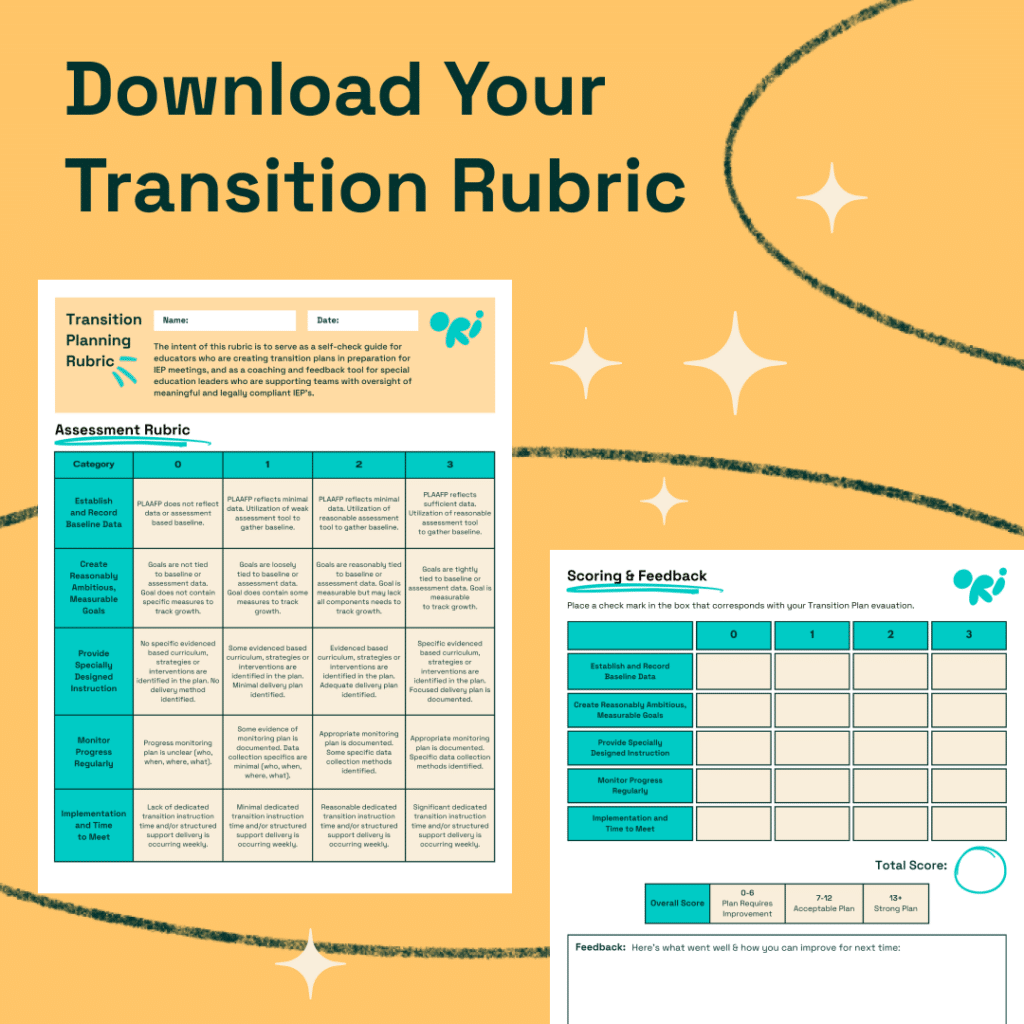


Online learning has become an integral part of the wider educational paradigm thanks to the exponential rate of technological progress and, more recently, the urgency of a global pandemic.
As far as the special education sector is concerned, these changes have proven to be a double-edged sword. While the traditional norms of the classroom and the textbook have been overhauled to address a wider array of needs, including that of enabling online learning for special needs students, this has not always resulted in a positive outcome for this group.
In this article, we will explore both the strengths and challenges of online learning in order to determine to what extent it is fit for purpose as an approach to special needs instruction.
Our Transition Planning Rubric is designed to support district leaders and educators in guiding their teams towards excellence in transition planning.
It provides comprehensive criteria that cover the breadth of transition planning, from gauging student engagement to evaluating post-secondary goals and services.
Expand your team’s capabilities and improve the success of IEP meetings.

Online learning is optimized for self-paced study. When using virtual environments such as Zoom or Microsoft Teams, classes and lectures can be easily recorded and stored in an online repository, such as Moodle, Canva or Schoology or indeed any other learning management system (LMS), where they can be accessed at any time and from anywhere.
This is a crucial resource for special education students, especially in cases where following along in real time might be particularly challenging. The ability to control the speed at which a recorded class is viewed, as well as pausing and rewinding, can help students with learning disabilities grasp complex concepts more effectively, allowing them to learn at their own pace and reducing the pressure of keeping up in real time.
Another key strength of an online-based education is the versatility of the digital medium, which makes it well-suited to individual learning styles and preferences.
In the context of online learning for special needs students, the educational material that is presented on the screen can be customized dynamically according to the nature of the student’s learning need with the help of adaptive, algorithm-powered learning technologies. This includes the use of text-to-speech functionality for students with visual impairments and closed-captioned instructional videos and lessons for students with auditory challenges or impairments.
Such multimodality can offer an additional layer of support to those who may struggle with traditional, text-based learning by providing content in more accessible formats.
While the interface of a virtual learning environment might appear to be lacking in the physical presence and personal approach that a team of teachers can bring to a real classroom, being online can in some cases actually enhance communication and cooperation between student and teacher.
To give just one example, a teacher may decide to take students aside in a break-out room to address challenging or disruptive behaviors without having to single them out in front of an entire class, while also not interfering with the learning of others. This takes away the stress and tension that such a situation would otherwise generate for students and teachers alike.
Platforms such as Microsoft Teams and Zoom may create a semblance of face-to-face interaction in a virtual setting, but this is not enough to justify denying in-person support to students who rely on it the most, namely those with more severe disabilities.
This is brought to light by one study exploring the social validity of distance-learning programs for students with such disabilities: 90% of children required that a parent sit next to them for the duration of the program, while 60% required a staff member to be in a breakout room.
Despite making such accommodations, it was clearly not enough to offset the notable absence of in-person interactions, with the majority of parents and teachers (55% and 54.5% respectively) agreeing that switching to a virtual mode of engagement negatively impacted students’ education overall.
These findings serve to reinforce the argument that online learning for special needs students should not be treated as a one-size-fits-all solution, and that additional provisions need to be made for those with severe developmental disabilities and high behavioral needs in order for it to be considered successful across the board.
Understand the wider landscape of the challenges faced by the special education sector, including the issue of disproportionality.

The ability of technology to extend the classroom beyond its physical confines has played a crucial role in times of crisis, most recently during the Covid-19 pandemic. Nevertheless, we cannot overlook the concerning fact that the implementation of Individualized Education Programs (IEPs) for special needs students forced to study from home during this period were far from consistent.
The Harvard Law School Project on Disability studied how 24 U.S. school districts adapted their teaching methods and services for students with disabilities at the beginning of the pandemic. They found big differences in how well these students’ needs were met while learning from home, even within the same district.
For instance, almost half of these districts (45%) implemented only one or none of the four key measures to adapt the students’ IEPs for online learning. Furthermore, none of the districts adopted the same strategies despite being comparable in terms of available resources.
In addition, a student survey conducted as part of a joint study conducted by researchers from the Applied Science Private University, Amman, and Najran University listed “Adjusting of online courses to deaf or hard of hearing students and students with disabilities” as the most significant challenge they experienced in the transition to online learning during the pandemic.
The special education sector was by no means unique in falling short of the requirements. However, the above results indicate a need for more federal guidance on strategies to ensure quality education standards are met under the Individuals with Disabilities Education Act (IDEA) in a remote learning environment.
Online learning offers recorded lessons for self-paced study, accessible content in various formats, and break-out rooms for class management.
The challenges include limited face-to-face interaction for students with severe disabilities and inconsistent IEP implementation across districts.
Technology plays a pivotal role in adapting content based on individual students’ progress and needs. Additionally, virtual and augmented reality tools can provide immersive and interactive experiences which facilitate learning.
This brief analysis of online learning demonstrates its immense potential to be a resource for learning success for students with special needs, but only provided that adequate steps are taken towards implementing this modality in a way which takes into account the specific and individual learning needs of students.
Ori Learning offers a research-based solution which is designed to accommodate a variety of use cases. It can be used for multiple modes of instruction and delivery styles depending on location and available resources, including face to face, hybrid and fully online/distance learning.
Receive custom support backed by rich industry experience that can help you tackle your strategic goals at scale. Request a free demo of our platform to experience first-hand its powerful accommodation and translation features, automated reporting tools, and intuitive design.


